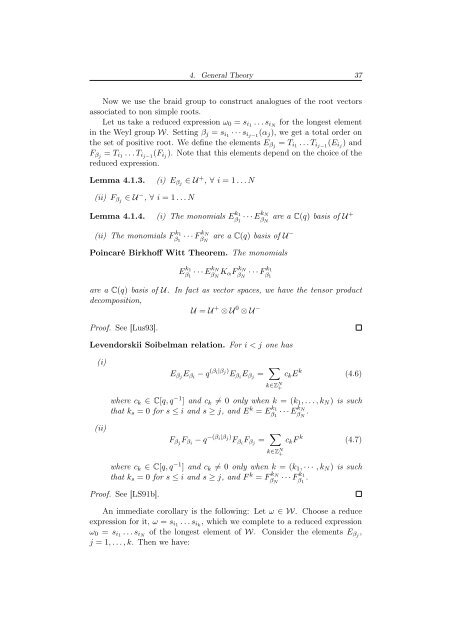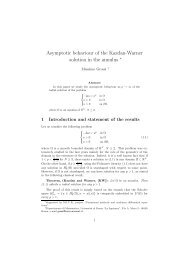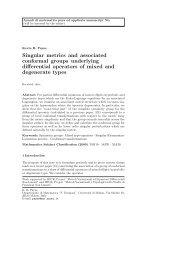Degree of Parabolic Quantum Groups - Dipartimento di Matematica ...
Degree of Parabolic Quantum Groups - Dipartimento di Matematica ...
Degree of Parabolic Quantum Groups - Dipartimento di Matematica ...
Create successful ePaper yourself
Turn your PDF publications into a flip-book with our unique Google optimized e-Paper software.
4. General Theory 37<br />
Now we use the braid group to construct analogues <strong>of</strong> the root vectors<br />
associated to non simple roots.<br />
Let us take a reduced expression ω0 = si1 . . .siN for the longest element<br />
in the Weyl group W. Setting βj = si1 · · ·sij−1 (αj), we get a total order on<br />
the set <strong>of</strong> positive root. We define the elements Eβj = Ti1 . . . Tij−1 (Eij ) and<br />
Fβj = Ti1 . . .Tij−1 (Fij ). Note that this elements depend on the choice <strong>of</strong> the<br />
reduced expression.<br />
Lemma 4.1.3. (i) Eβj ∈ U+ , ∀ i = 1...N<br />
(ii) Fβj ∈ U − , ∀ i = 1...N<br />
Lemma 4.1.4. (i) The monomials E k1 · · ·EkN β1 βN<br />
(ii) The monomials F k1 kN · · ·F β1 βN<br />
are a C(q) basis <strong>of</strong> U −<br />
Poincaré Birkh<strong>of</strong>f Witt Theorem. The monomials<br />
E k1<br />
β1<br />
kN k1<br />
· · ·EkN KαF · · ·F βN βN β1<br />
are a C(q) basis <strong>of</strong> U+<br />
are a C(q) basis <strong>of</strong> U. In fact as vector spaces, we have the tensor product<br />
decomposition,<br />
U = U + ⊗ U 0 ⊗ U −<br />
Pro<strong>of</strong>. See [Lus93].<br />
Levendorskii Soibelman relation. For i < j one has<br />
(i)<br />
(ii)<br />
EβjEβi − q(βi|βj) <br />
EβiEβj =<br />
k∈Z N +<br />
ckE k<br />
(4.6)<br />
where ck ∈ C[q, q −1 ] and ck = 0 only when k = (k1, . . .,kN) is such<br />
that ks = 0 for s ≤ i and s ≥ j, and E k = E k1<br />
β1<br />
FβjFβi − q−(βi|βj) <br />
FβiFβj =<br />
k∈Z N +<br />
· · ·EkN<br />
βN .<br />
ckF k<br />
(4.7)<br />
where ck ∈ C[q, q −1 ] and ck = 0 only when k = (k1, · · · , kN) is such<br />
that ks = 0 for s ≤ i and s ≥ j, and F k = F kN<br />
βN<br />
Pro<strong>of</strong>. See [LS91b].<br />
· · ·F k1<br />
β1 .<br />
An imme<strong>di</strong>ate corollary is the following: Let ω ∈ W. Choose a reduce<br />
expression for it, ω = si1 . . .sik , which we complete to a reduced expression<br />
ω0 = si1 . . .siN <strong>of</strong> the longest element <strong>of</strong> W. Consider the elements Eβj ,<br />
j = 1, . . .,k. Then we have:








